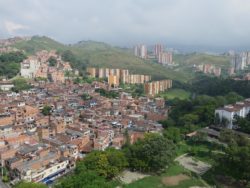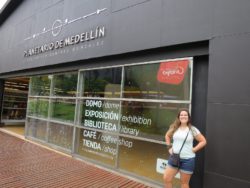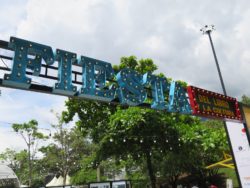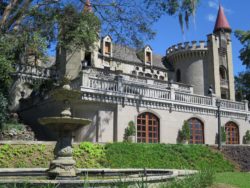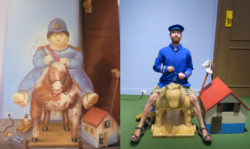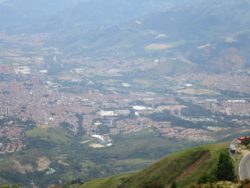Medellín: Colombia’s Modern City
Medellín, a city once infamous only for Pablo Escobar’s reign of terror, is now Colombia’s most modern, progressive metropolis, transforming itself from the murder capital of the world in 1991 to the world’s most innovative city in 2013. Investments into the education, culture, and infrastructure of the city have engendered social change on a scale rarely seen, helped along by Colombia’s fervent desire to stand apart from (but never forget) its violent past. Medellín is now not only a safe, prosperous hometown to over 2 million Colombianos, but a popular tourist destination as well, and for good reason.
Medellín is situated in the Aburrá Valley, the city center filling out the lowest part of the valley, with the favelas sprawling up the surrounding mountainsides. The city’s public transportation system is extensive, making it extremely easy to get around. There are two main metro rail lines, a large network of buses, and numerous cable car lines reaching up to the overlooking favelas. The metro system itself has actually been credited with a marked reduction in violence, crime, and poverty, as the lack of opportunities in the far-flung districts was largely due to the inaccessibility of the economic hub of the center. What was previously an hours-long walk down a steep mountainside is now a ten minute ride in a cable car that is affordable to anyone; a ride from anywhere in the city to anywhere else costs the equivalent of $0.70.
On our first day we visited the planetarium in the University district of the city, a small but very well done museum containing several hands-on exhibits exploring various aspects of the universe from gravity to planetary formation to time dilation. There is also a large dome theater showing immersive short films, in Spanish of course, about the origins of life, the universe, and everything (don’t forget your towel).
We had the good fortune of stumbling upon the nearby Books and Culture Festival, taking place in the Botanical Gardens of Medellín. The festival was a gathering and celebration of literature and culture, bringing together hundreds of authors, publishers, and booksellers. There were booths set up for different genres, mediums, and interests; some specialized in rare first-editions, some just on children’s literature, and (our personal favorite) some were just for comics and memorabilia. There were also numerous food and beer vendors set up, which we gladly took advantage of. The botanical gardens themselves would have been worth a visit even without the festival; they boast more than 1,000 different species of flowers, trees, and other flora. There are sections set up to emulate the desert, rainforest, jungle, and other biomes, and a good number of the plants were previously unbeknownst to us.
Located in the El Poblado region of the city is the somewhat anachronistic Museo el Castillo, a Gothic medieval-style castle built in the 1930’s. It has gardens, a library, numerous art pieces, and a great view of the rest of Medellín. Admission was 10,000 COP and included a guided tour of the castle. There is also a restaurant on the premises in case you get hungry.
Another place of interest was the Museo de Antioquia, a large museum in the heart of the city populated largely by works donated by Medellín native Fernando Botero. Botero, one of Colombia’s most famous artists, is known for his particular style of painting and sculpture, known appropriately as Boterismo, which portrays people and objects as large, grossly exaggerated versions of themselves. The museum contains a wide selection of paintings and sculptures by Botero, as well as numerous works by artists from around the world.
The highlight of the visit was undoubtedly our paragliding expedition. We took a bus an hour up into the mountains surrounding the city, where we strapped on a harness and clipped into a tandem parachute. We were situated at the top of a steep hill, where the parachute was prepared, until finally our guides told us, at two different times, to start running down the hill. After four or five steps, the parachute filled up, and suddenly the ground fell away. The guide handled the actual maneuvering, so the rest of the ten-minute ride was spent marveling at the city below and enjoying the sensation of flying with nothing more than a large strip of fabric keeping us aloft.
There’s far too much to do and see in Medellín to mention in just one blog post. We celebrated the weekend like locals by dancing (albeit poorly) at the salsa clubs in the Laureles district, ate some great authentic Colombian food at Mondongo’s, a famous restaurant with branches in both Medellín and Miami, partied with tourists and locals alike in the El Poblado district, a very hip, upscale area of the city, and enjoyed plenty of culture and food in between (the salchipapas, basically french fries with sausage bits and mystery sauces, were a particular favorite). Of all the cities we’ve visited in Colombia so far, Medellín is the one I could see myself coming back to for a long period of time. It has all the conveniences of a modern city without sacrificing its unique Latin American culture. Given its tumultuous history, it is also a great example of how a city can transform through the efforts of its government and its people.

